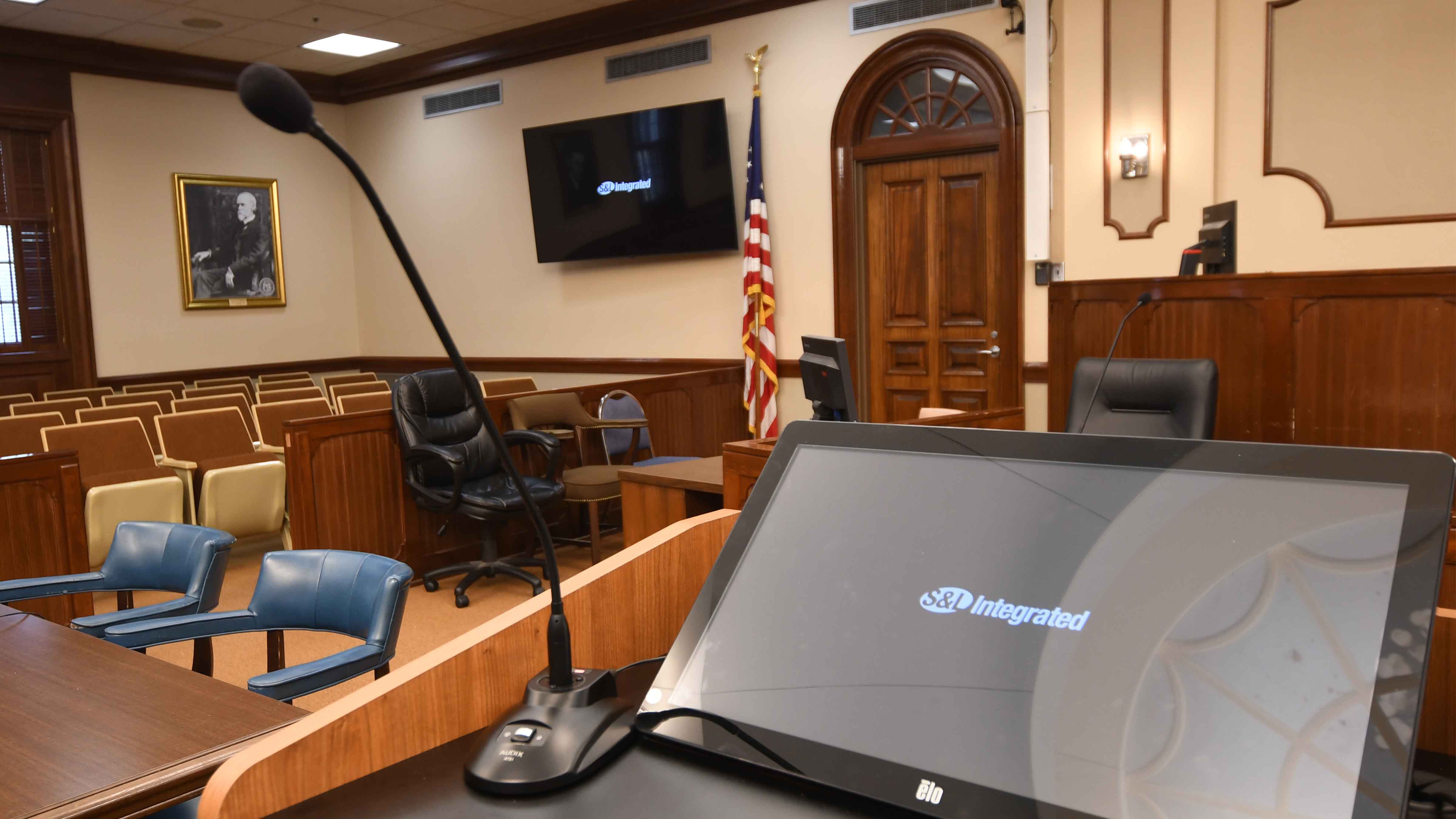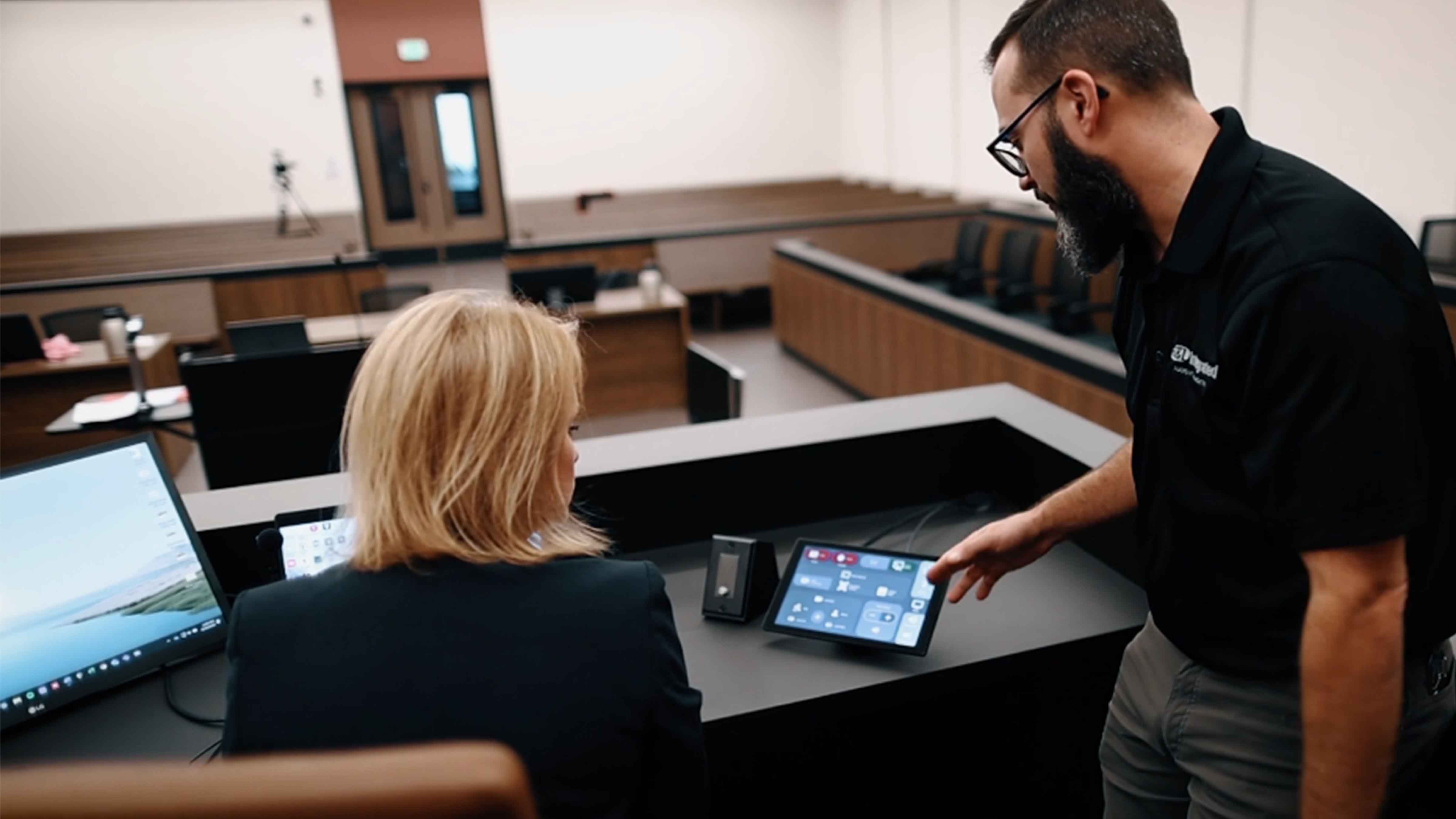Completed in Fall 2024, the Maury County Judicial Center in Columbia, TN, is a newly constructed, 58,000-square-foot facility designed to accommodate a growing region while modernizing court proceedings at the same time. Nashville, TN-based architect Workshop oversaw planning and building design, while S&L Integrated, headquartered in Thomasville, GA, deployed the courtroom AV systems.
[Here's How AI Poses Ethical, Legal Issues to Content Producers]
two-story building, the new courthouse houses six courtrooms, three on each floor. Upstairs, one jury courtroom features a traditional layout, with the jury box to the side of the bench and attorney tables. The other two incorporate the Virginia Revival Model (VRM), which puts the jury in front of the judge’s bench. Four associated enclosed spaces are assigned to each courtroom, providing attorneys and their clients with somewhere to meet privately.
For architect Workshop, one design goal was to incorporate elements referencing Maury County’s historic courthouse building a few blocks away in Columbia’s downtown core. For example, the pews positioned throughout the public hallways were extracted from the historic building and refurbished for the Judicial Center. The thin film coverings on the private conference room windows, featuring images depicting Maury County’s history, are another element.
“Recognizing that they were moving from the historic courthouse was very important to them,” James Kennon, principal architect at architect Workshop, explained in a video produced by S&L Integrated. “We worked with the county archives to develop a series of photos that told the history of the county.”
Digital Evidence Support
From a technological perspective, Maury County needed courtroom AV systems that could support digital evidence such as body and dashcam footage as well as surveillance videos, explained Stan Mobley, senior account executive for state, local, and corporate clients at S&L Integrated. This need is prevalent among the courthouses his firm works with in Georgia and Tennessee, as is the integration of reliable videoconferencing capabilities and user-friendly control.
To address this, S&L Integrated developed a courtroom AV package that can be tailored to meet specific client requirements. In general, it includes Crestron DM NVX AV over IP distribution, Q-SYS control, QSC ceiling speakers, Marshall POV cameras, LG displays, a combination of Audix microphones and Sennheiser wireless systems, and WolfVision whiteboard and annotation tools (when requested).
At the Maury County Judicial Center, the primary goal was to provide a good user experience for everyone working in the courtroom, including the judge, attorneys, court clerk, court reporter, and other staff. To achieve this, it’s necessary to understand how each judge runs his or her courtroom, explained Nathan Tomberlin, account executive at S&L Integrated. For example, do they want the ability to approve digital evidence before attorneys share it wirelessly to courtroom displays? If so, their touchpanel must be equipped with “preview” and “approve” commands.
“This is putting protections in place to follow the due process of how the judge wants to manage the court proceeding,” Tomberlin said. “It puts all of the power back on the judge.”
Control Flexibility
It can also allow for flexibility. During particularly intense proceedings, a judge may give the court clerk authorization to run the technology from their own touchpanel, so the judge can keep their focus on witness testimony. Good control programming can also simplify things for the court reporter, who may access and modify mic volumes through their touchscreen.
“They don’t have to go through their software with their mouse to click on the microphone levels to get them right,” Tomberlin said. “Instead, we give them a touchpanel and they can make any adjustments right there on the screen.”
While each courthouse is different, they all share common requirements, which is why S&L Integrated offers a courtroom AV package. As Mobley explained, this promotes standardization across courthouses, which facilitates service and support for the AV integrator. Perhaps more importantly, it provides a smoother user experience.
“Within a circuit, there may be three judges and six courts,” Mobley added. “The courtrooms may look different—some may be modern while others are historic. But when we standardize the systems, a judge coming from County A to County C doesn’t have to spend time learning a system that’s unfamiliar to him. He has a touchpanel that looks exactly like the one in his home court.”
Court-Appointed Audio Capture

Part of the AV package that S&L Integrated proposes to its courthouse clients includes a combination of Audix conferencing microphones, such as the MG18 and MG18HC gooseneck condenser mics mounted in the ATS1 tabletop base, as well as ADX60 boundary mics to capture speech from those who aren’t equipped with a dedicated microphone.
“From an audio perspective, the most important person in the room is the witness,” said Gage Helton, director of operations at S&L Integrated. “The second most important is the judge. Then, obviously, you need to be able to hear the jury. Many contractors that do general purpose installations don’t make things audible enough when they do courtrooms, or there’s feedback because they didn’t EQ the room. For this reason, we tend to use column array speakers, tune them, then the MG18 mics in most places. But for positions closer to the arrays, we’ll opt for the MG18HC, which is essentially the same mic with a hypercardioid pickup pattern.”
Witness and jury foreman mics are usually shock-mounted, with everything else mounted on the ATS1 bases. The ADX60s are placed on prosecution and defense attorneys’ tables to capture sidebar discussions.
Helton noted that the ATS1 base’s physical button is easier for non-technical operators to use, versus bases that incorporate either a touchscreen or capacitive button. “We’ve found that users can get confused by those—especially when you factor in the stress that comes with being in court—and either fail to trigger them when it’s their turn to speak or accidentally turn them on when it’s not,” he explained.
he unit’s detachable cable also makes for smoother installs. “A lot of gooseneck bases for conferencing have an attached cable, so you need to figure out how to dress it and route it in an unobtrusive way. With the ATS1, we can just run our own cable and terminate, which makes the install so much cleaner,” he said.
While this may seem like a lot of microphones, there is a need to take all courtroom participants into account. “One reason is, in many installs we send multitrack audio to the court reporter so they can produce the most accurate transcript possible,” Helton said. “Another is that we like to have a press feed plate for higher-profile cases, so reporters can just plug in and get a clean audio mix. For larger courtrooms, we’ll also do a mix-minus through small speakers at various locations, so the participants can hear everyone else clearly but not have echo of themselves.”
